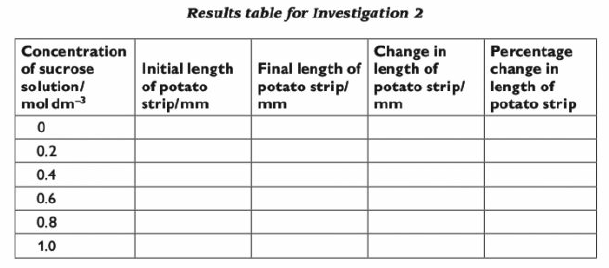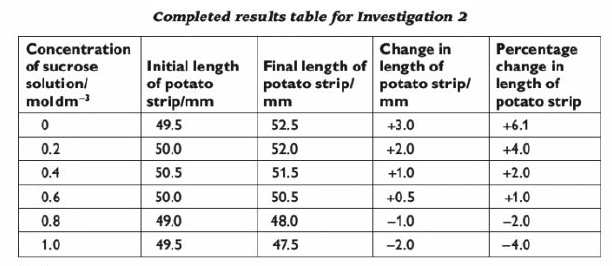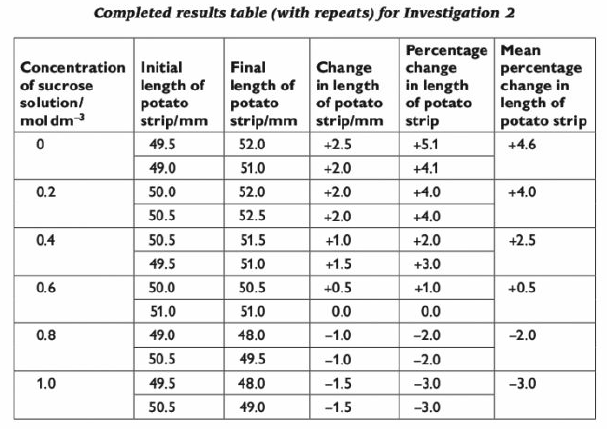Biology
 You will often need to construct a table in which to record your measurements, readings and other observations. It is always best to design and construct your results table before you begin your experiment, so that you can write your readings directly into it as you take them.
You will often need to construct a table in which to record your measurements, readings and other observations. It is always best to design and construct your results table before you begin your experiment, so that you can write your readings directly into it as you take them.
Let's think about investigation 2 again (investigating the effect of immersion in solutions of different sucrose concentration on the change in mass of potato strips). You've made your decisions about the range and intervals of the independent variable (concentration of solution) - you've decided to use six concentrations ranging from 0.0 moldm-3 to 1.0 moldm-3. Your dependent variable is the change in length of the potato strips, and you are going to find this by measuring the initial length and final length of each strip.
These are the things you need to think about when design ing your results table:
? The independent variable should be in the first column.
? The readings you take are in the next columns.
? Sometimes, these readings actually are your dependent variable, in this experiment, however, you are going to have to use these readings to calculate your dependent variable, which is the change in length of the strips, so you need to have another column for this. This comes at the end of the table. In fact, you really need to work out the percentage change in length of the strips, as this will allow for the inevitable variability in the initial lengths of the strips.
The table could look like this:

Notice:
? The table has been clearly drawn, with lines separating all the different rows and columns. Allways use a pencil and ruler to draw a results table.
? Each column is fully headed, including the unit in which that quantity is going to be measured. The unit is preceded by a slash /. You can use brackets instead - concentration of sucrose solution (moldm-3).
? The slash always means the same thing. It would be completely wrong to write: concentration of sucrose solution/mnol/dm-3 as the heading of the first column. That would be really confusing. If you are not happy using negative indices like dm-3, you can always write 'per' instead. So it would be fine to write: concentration of sucrose solution/mol per dm-3.
? The columns are all in a sensible order. The first one is the independent variable, so you can write these values in straight away, as you have already decided what they will be. The next thing you will measure is the initial length of the strip, then the final length. Then you will calculate the change in length, and finally you will calculate the percentage change in length.
So now you are ready to do your experiment and collect your results. Here is what your table might look like.

Notice:
? All the measurements in the second two columns were made to the nearest 0.5 mm. This is because the smallest graduation on the scale on the ruler was 1 mm. So it was possible to estimate the length to the nearest 0.5mm. (Have a look at the scale on your ruler, and you will see that this is sensible.) Even if you decide that a length is exactly 50mm, you must write in the next decimal place for consistency, so you would write 50.0.
? The values in the 'change in length' column each show whether they were an increase or a decrease.
? The percentage change in length is calculated like this:
 (Do make sure you remember to take a calculator into the exam with you.)
(Do make sure you remember to take a calculator into the exam with you.)
? Each percentage change in length has been rounded up to one decimal place, for consistency with the change in length. For example, the calculation in the first row gives 6.0606, which you should round up to 6.1. The calculation in the sixth row gives 4.0404, which rounds up to 4.0.
Repeats
It is a good idea to do repeats. This means that, instead of getting just one reading for each value of your independent variable, you collect two or three. You can then calculate a mean value, which is more likely to be a 'true' value than any of the individual ones.
Let's say that you did this for the potato strip experiment. You could have used two potato strips for each sucrose concentration, then calculated the percentage change in length for each one, then finally calculated a mean percentage change.
This means adding some extra rows and an extra column to the results table, like this:

Notice:
? All of this information has been put in a single results table. This makes it much easier for someone to read and find all the information they need.
? The numbers in the final column have again been rounded up to one decimal place.
Qualitative observations
The results table for the potato strip experiment contains numerical values - they are quantitative. Sometimes, though, you may want to write descriptions in your results table, for example a colour that you observed. These are qualitative observations. If you are recording colours, write down the actual colour - do not just write 'no change'.
Use simple language that everyone can easily understand. Avoid using terms that are difficult for the examiner to interpret, such as 'yellowish-green'. Think about what is important - perhaps it is that this tube is a darker or lighter green than that tube. Using simple language such as 'dark green' or 'a lighter green than tube 1' is fine.
- Diffusion And Osmosis
Movement in a and out of cells (some key terms): Diffusion: the movement of a substance from a high concentration to a lower one as a result of their random movement. Give an example of diffusion Osmosis: The diffusion of water molecules from a...
- #74 Identifying Sources Of Error
It is very important to understand the difference between experimental errors and 'mistakes'. A mistake is something that you do incorrectly, such as misreading the scale on a thermometer, or taking a reading at the wrong time, or not emptying...
- # 72 Graphs And Other Ways Of Displaying Data
When you have collected your data and completed your results table, you will generally want to display the data so that anyone looking at them can see any patterns. 1. Line graphs Line graphs are used when both the independent variable and...
- #70 Practical Exam - Taking Measurements
You will often be asked to take measurements or readings. In biology, these are most likely to be length, mass, time, temperature or volume. You could be taking readings from a linear scale (for example, reading temperature on a thermometer, reading...
- #69 How To Get High Marks In Paper 3 - Variables
Many of the experiments that you will do during your AS course, and usually Question 1 in the examination paper, will investigate the effect of one factor on another. These factors are called variables. Types of variables The factor that you change...
Biology
#71 Recording measurements and other data

Let's think about investigation 2 again (investigating the effect of immersion in solutions of different sucrose concentration on the change in mass of potato strips). You've made your decisions about the range and intervals of the independent variable (concentration of solution) - you've decided to use six concentrations ranging from 0.0 moldm-3 to 1.0 moldm-3. Your dependent variable is the change in length of the potato strips, and you are going to find this by measuring the initial length and final length of each strip.
These are the things you need to think about when design ing your results table:
? The independent variable should be in the first column.
? The readings you take are in the next columns.
? Sometimes, these readings actually are your dependent variable, in this experiment, however, you are going to have to use these readings to calculate your dependent variable, which is the change in length of the strips, so you need to have another column for this. This comes at the end of the table. In fact, you really need to work out the percentage change in length of the strips, as this will allow for the inevitable variability in the initial lengths of the strips.
The table could look like this:

? The table has been clearly drawn, with lines separating all the different rows and columns. Allways use a pencil and ruler to draw a results table.
? Each column is fully headed, including the unit in which that quantity is going to be measured. The unit is preceded by a slash /. You can use brackets instead - concentration of sucrose solution (moldm-3).
? The slash always means the same thing. It would be completely wrong to write: concentration of sucrose solution/mnol/dm-3 as the heading of the first column. That would be really confusing. If you are not happy using negative indices like dm-3, you can always write 'per' instead. So it would be fine to write: concentration of sucrose solution/mol per dm-3.
? The columns are all in a sensible order. The first one is the independent variable, so you can write these values in straight away, as you have already decided what they will be. The next thing you will measure is the initial length of the strip, then the final length. Then you will calculate the change in length, and finally you will calculate the percentage change in length.
So now you are ready to do your experiment and collect your results. Here is what your table might look like.

? All the measurements in the second two columns were made to the nearest 0.5 mm. This is because the smallest graduation on the scale on the ruler was 1 mm. So it was possible to estimate the length to the nearest 0.5mm. (Have a look at the scale on your ruler, and you will see that this is sensible.) Even if you decide that a length is exactly 50mm, you must write in the next decimal place for consistency, so you would write 50.0.
? The values in the 'change in length' column each show whether they were an increase or a decrease.
? The percentage change in length is calculated like this:

? Each percentage change in length has been rounded up to one decimal place, for consistency with the change in length. For example, the calculation in the first row gives 6.0606, which you should round up to 6.1. The calculation in the sixth row gives 4.0404, which rounds up to 4.0.
Repeats
It is a good idea to do repeats. This means that, instead of getting just one reading for each value of your independent variable, you collect two or three. You can then calculate a mean value, which is more likely to be a 'true' value than any of the individual ones.
Let's say that you did this for the potato strip experiment. You could have used two potato strips for each sucrose concentration, then calculated the percentage change in length for each one, then finally calculated a mean percentage change.
This means adding some extra rows and an extra column to the results table, like this:

? All of this information has been put in a single results table. This makes it much easier for someone to read and find all the information they need.
? The numbers in the final column have again been rounded up to one decimal place.
Qualitative observations
The results table for the potato strip experiment contains numerical values - they are quantitative. Sometimes, though, you may want to write descriptions in your results table, for example a colour that you observed. These are qualitative observations. If you are recording colours, write down the actual colour - do not just write 'no change'.
Use simple language that everyone can easily understand. Avoid using terms that are difficult for the examiner to interpret, such as 'yellowish-green'. Think about what is important - perhaps it is that this tube is a darker or lighter green than that tube. Using simple language such as 'dark green' or 'a lighter green than tube 1' is fine.
- Diffusion And Osmosis
Movement in a and out of cells (some key terms): Diffusion: the movement of a substance from a high concentration to a lower one as a result of their random movement. Give an example of diffusion Osmosis: The diffusion of water molecules from a...
- #74 Identifying Sources Of Error
It is very important to understand the difference between experimental errors and 'mistakes'. A mistake is something that you do incorrectly, such as misreading the scale on a thermometer, or taking a reading at the wrong time, or not emptying...
- # 72 Graphs And Other Ways Of Displaying Data
When you have collected your data and completed your results table, you will generally want to display the data so that anyone looking at them can see any patterns. 1. Line graphs Line graphs are used when both the independent variable and...
- #70 Practical Exam - Taking Measurements
You will often be asked to take measurements or readings. In biology, these are most likely to be length, mass, time, temperature or volume. You could be taking readings from a linear scale (for example, reading temperature on a thermometer, reading...
- #69 How To Get High Marks In Paper 3 - Variables
Many of the experiments that you will do during your AS course, and usually Question 1 in the examination paper, will investigate the effect of one factor on another. These factors are called variables. Types of variables The factor that you change...
